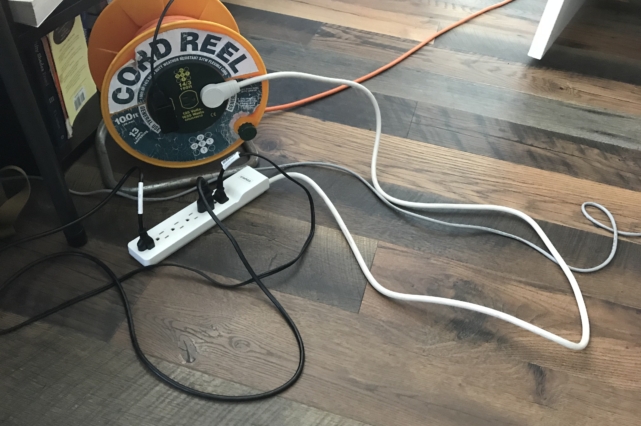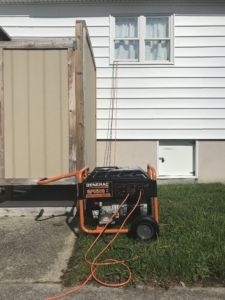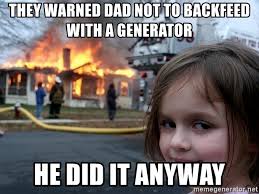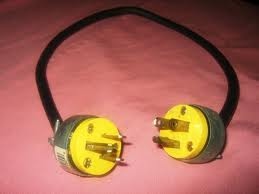
Generator Safety! Don’t Be Like Bob!
So, you purchased a brand-new portable generator to back up your house in an emergency. You have a shiny new toy in your garage or shed and a little peace of mind but what you do when the power actually goes out is critical to that peace of mind and safety of you and your loved ones.
 Don’t Be Like Bob!
Don’t Be Like Bob!
Expectations: Remember that a portable generator is only designed to keep select essential circuits operating during a power outage. Only the largest portable generators have the power capacity to back up your entire home. Turning off some breakers helps to resolve this issue but does not balance the loads. The generator supplies 240 volts split between two, 120-volt lines. Each line delivers half the generator’s capacity. If most or all essential circuits end up on the same line, the unbalanced load puts a strain on the generator and the home can only use half the generator’s capacity.
Safety: Where you locate your generator is crucial to your safety, that of your loved ones as well as your neighbors. Gas and diesel fumes can be deadly. Do not place a portable generator near a window or ventilation system. Do not direct the exhaust towards a neighbor’s window. Check your local codes. Do not set up your portable generators indoors
Cord Safety: Do not run extension cords through an open window – exposing your house to toxic fumes, heat or cold, and weather. The extension cords will create tripping hazards for yourself your children and especially the elderly. A new cord in the house is also an invitation for an animal to inspect and chew!
 Don’t be like Bob!
Don’t be like Bob!
Do not back feed a house, apartment, or business, it is dangerous and illegal. Back feeding a service panel energizes the entire circuit panel. People who back feed their houses connect the generator to an outlet with a homemade cord fitted with two male plugs. With a Generator Back feed Cord, sometimes called a suicide cord, electrical power enters the main panel through the outlet’s branch circuit breaker. The panel distributes the power to the rest of the house through the other branch circuit breakers. It also feeds power out through the main breaker to the transformer, which then converts it back to thousands of volts and tries to energize all neighborhood utility lines.
Energizing the utility lines in this fashion is dangerous and illegal. Workers trying to restore power to the neighborhood may unexpectedly encounter high voltage on the utility lines and suffer a fatal shock.
Turning off the main breaker alleviates the hazard, but doing so relies on someone to shut the main breaker off. There is no guarantee that someone else will not turn the main breaker back on and energize the neighborhood wires. This arrangement provides no safeguards against accidentally energizing the utility lines or introducing an electrocution hazard in the home.
 Don’t Be Like Bob!
Don’t Be Like Bob!
A Generator Back feed cord introduces electrocution hazard. If the plug inside the house falls out of the appliance outlet, the cord has 240 volts across its terminals. Anyone stumbling onto the cord or tripping over it may receive an electric shock. Thus, the aptly named “Generator Suicide Cord.”
A BETTER SOLUTION: A Manual Transfer Switch
A manual transfer switch isolates the home electrical system from the utility lines before it connects the power from the generator. The switch distributes power to the branch circuits the homeowner selected during installation. Each circuit has its own breaker, and electrical power can’t leave the dwelling. It will not power the neighborhood utility lines or endanger workers. When the utility restores power, the transfer switch protects the generator from damage caused by the sudden introduction of another power source.
The generator load stays balanced because the transfer switch distributes the load equally between the two 120-Volt lines. The balanced load puts less strain on the generator, saves fuel, and allows utilization of the generator’s full capacity.
